Related Research Articles

Periclase is a magnesium mineral that occurs naturally in contact metamorphic rocks and is a major component of most basic refractory bricks. It is a cubic form of magnesium oxide (MgO). In nature it usually forms a solid solution with wüstite (FeO) and is then referred to as ferropericlase or magnesiowüstite.

Autunite (hydrated calcium uranyl phosphate), with formula Ca(UO2)2(PO4)2·10–12H2O, is a yellow-greenish fluorescent phosphate mineral with a hardness of 2–2+1⁄2. Autunite crystallizes in the orthorhombic system and often occurs as tabular square crystals, commonly in small crusts or in fan-like masses. Due to the moderate uranium content of 48.27% it is radioactive and also used as uranium ore. Autunite fluoresces bright green to lime green under UV light. The mineral is also called calco-uranite, but this name is rarely used and effectively outdated.

Sellaite is a magnesium fluoride mineral with the formula MgF2. It crystallizes in the tetragonal crystal system, typically as clear to white vitreous prisms. It may be fibrous and occur as radiating aggregates. It has a Mohs hardness of 5 to 6 and a specific gravity of 2.97 to 3.15. Refractive index values are nω = 1.378 and nε = 1.390.

Natrolite is a tectosilicate mineral species belonging to the zeolite group. It is a hydrated sodium and aluminium silicate with the formula Na2Al2Si3O10 · 2H2O. The type locality is Hohentwiel, Hegau, Germany.

Lithiophilite is a mineral containing the element lithium. It is lithium manganese(II) phosphate with chemical formula LiMnPO4. It occurs in pegmatites often associated with triphylite, the iron end member in a solid solution series. The mineral with intermediate composition is known as sicklerite and has the chemical formula Li(Mn,Fe)PO4). The name lithiophilite is derived from the Greek philos (φιλός) "friend," as lithiophilite is usually found with lithium.

Babingtonite is a calcium iron manganese inosilicate mineral with the formula Ca2(Fe,Mn)FeSi5O14(OH). It is unusual in that iron(III) completely replaces the aluminium so typical of silicate minerals. It is a very dark green to black translucent mineral crystallizing in the triclinic system with typically radial short prismatic clusters and druzy coatings. It occurs with zeolite minerals in cavities in volcanic rocks. Babingtonite contains both iron(II) and iron(III) and shows weak magnetism. It has a Mohs hardness of 5.5 to 6 and a specific gravity of 3.3.
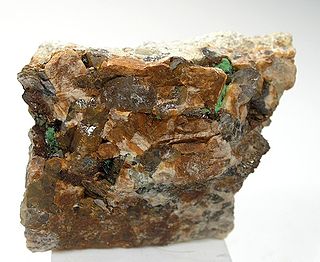
Ulrichite is a rare green uranium phosphate mineral (CaCu(UO2)[PO4]2·4H2O). It crystallizes as monoclinic prisms which occur as apple green acicular radiating clusters. It is radioactive and exhibits strong yellow fluorescence under ultraviolet radiation.

Howlite, a calcium borosilicate hydroxide (Ca2B5SiO9(OH)5), is a borate mineral found in evaporite deposits.
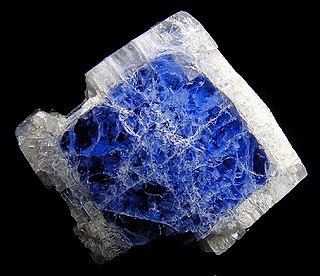
Carletonite is a rare silicate mineral with formula KNa4Ca4(CO3)4Si8O18(F,OH)·(H2O).
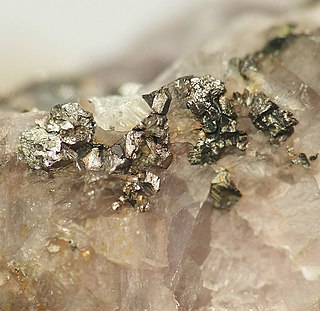
Cattierite (CoS2) is a cobalt sulfide mineral found in the Democratic Republic of Congo. It was discovered together with the nickel sulfide vaesite by Johannes F. Vaes, a Belgian mineralologist and named after Felicien Cattier, who was chairman of the board of the Union Minière du Haut-Katanga.

Dundasite is a rare lead aluminium carbonate mineral. The mineral is named after the type locality, Dundas, Tasmania, Australia. The mineral was first discovered in the Adelaide Proprietary Mine. Dundasite was first described by William Frederick Petterd in 1893.

Gonnardite is a comparatively rare, fibrous zeolite, natrolite subgroup. Older papers claim that a complete solid solution exists between tetranatrolite and gonnardite, but tetranatrolite was discredited as a separate species in 1999. A series, based on the disorder of the silicon-aluminum in the framework, appears to exist between Na-rich gonnardite and natrolite, Na2(Si3Al2)O10·2H2O.

Francevillite is a uranyl-group vanadate mineral in the tyuyamunite series. Its chemical formula is (Ba,Pb)(UO2)2V2O8·5(H2O). Francevillite is a strongly radioactive mineral. It is typically orange, yellow or brownish yellow. It forms a series with curienite.
Madocite is a mineral with a chemical formula of Pb17(Sb,As)16S41. Madocite was named for the locality of discovery, Madoc, Ontario, Canada. It is found in the marbles of the Precambrian Grenville Limestone. It is orthorhombic and in the point group mm2. Its crystals are elongated and striated along [001] to a size of 1.5 mm.
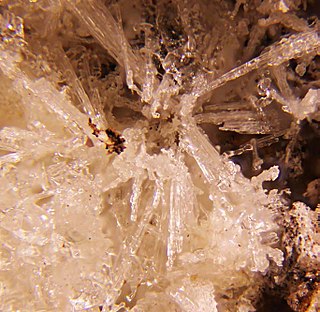
Fluoborite has a chemical formula of Mg3(BO3)(F,OH)3. Its name comes from its main chemical components, FLUOrine and BORon. It was first described in 1926.

Matlockite is a rare lead halide mineral, named after the town of Matlock in Derbyshire, England, where it was first discovered in a nearby mine. Matlockite gives its name to the matlockite group which consists of rare minerals of a similar structure.

Tuperssuatsiaite is a rare clay mineral found in Greenland, Namibia and Brazil. It is a hydrated phyllosilicate of sodium and iron.
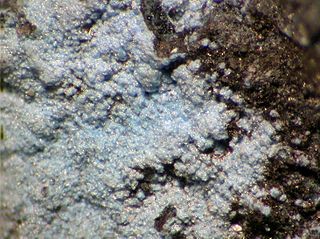
Spertiniite is a rare copper hydroxide mineral. Chemically it is copper(II) hydroxide with formula Cu(OH)2. It occurs as blue to blue green tabular orthorhombic crystal aggregates in a secondary alkaline environment altering chalcocite. Associated minerals include chalcocite, atacamite, native copper, diopside, grossular and vesuvianite.
Playfairite is a rare sulfosalt mineral with chemical formula Pb16Sb18S43 in the monoclinic crystal system, named after the Scottish scientist and mathematician John Playfair. It was discovered in 1966 by the Canadian mineralogist John Leslie Jambor. Lead gray to black in color, its luster is metallic. Playfairite shows strong reflection pleochroism from white to brownish gray. Playfairite has a hardness of 3.5 to 4 on Mohs scale and a specific gravity of approximately 5.72.
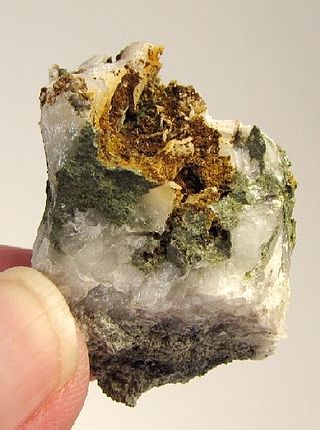
Trogtalite is a rare selenide mineral with the formula CoSe2. It crystallizes in the cubic system and is part of the pyrite group, consisting of Co2+ and Se22− ions. It has a rose-violet colour and its crystals are opaque. It often occurs as grains. It was thought to be dimorphous with hastite, but this was discredited in 2009. Hastite turned out to be the iron selenide mineral ferroselite. It forms a solid solution series with krut'aite.
References
- ↑ Warr, L.N. (2021). "IMA–CNMNC approved mineral symbols". Mineralogical Magazine. 85 (3): 291–320. Bibcode:2021MinM...85..291W. doi: 10.1180/mgm.2021.43 . S2CID 235729616.
- 1 2 3 "Guettardite". mindat.org. Hudson Institute of Mineralogy. Retrieved October 10, 2020.
- 1 2 3 Handbook of Mineralogy
- ↑ Webmineral data